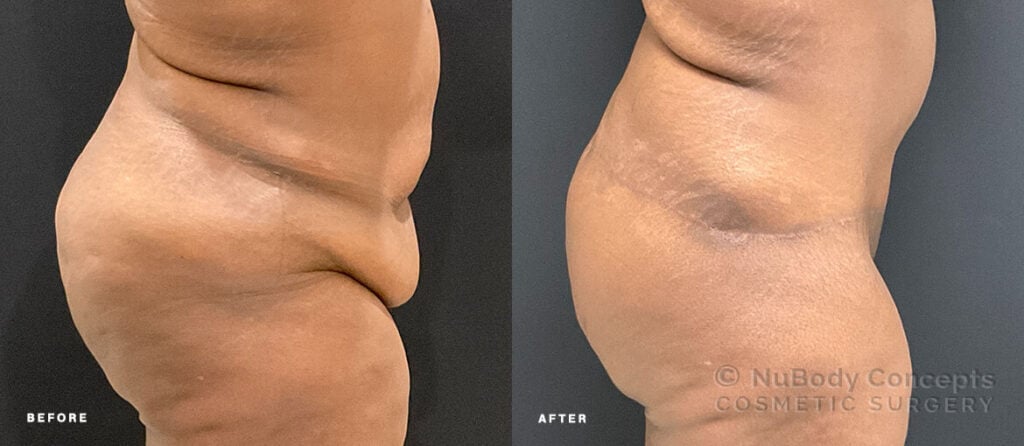
Medically reviewed by Dr. John Rosdeutscher – Written by Sine Thieme
Can I Have a Non-Surgical Tummy Tuck?
When we refer to a non-surgical tummy tuck, we are talking about radio frequency assisted lipolysis or RFAL. This is a minimally-invasive procedure that can achieve up to 60% skin contraction, which makes it an excellent alternative to a traditional tummy tuck. It is ideal for patients who have a moderate amount of excess fat and skin and wish to avoid the longer scar and recovery time of tummy tuck surgery.
Read on to learn everything you should know about skin tightening vs tummy tuck surgery. Let’s start by revisiting the surgical tummy tuck and its pros and cons.
Surgical Tummy Tuck
A surgical tummy tuck is the ultimate solution for patients with a flabby abdomen who want to get their youthful figure back. Diet and exercise may have failed to eliminate all of the extra fat, or you may have lost the weigh but are saddled with an excess of loose skin. A tummy tuck can remedy that.
For women in particular, pregnancy and childbirth can result in skin that is stretched too far to spring back into place. It can also damage the underlying muscles, which often need to be repaired as part of a tummy tuck. A tummy tuck is also great way to reposition and reshape a belly button that no longer looks aesthetically pleasing.
The downside of a tummy tuck is that it leaves a scar, and that of all plastic surgery procedures, it has one of the longest and most difficult recoveries. Furthermore, some people simply do not want to undergo surgery with its inherent risks.
Pros of Tummy Tuck Surgery
- Immediate results
- Removal of excess skin
- Removal of fat
- Includes muscle repair
- Reshapes belly button
- Great for BMIs of 30-35
Cons of Tummy Tuck Surgery
- Requires IV sedation
- Several weeks of recovery
- Visible scar
- Inherent risks of surgery
Non-Surgical Tummy Tuck (Skin Tightening)
Many patients can achieve results close to those of a tummy tuck with a less invasive skin tightening alternative powered by radio frequency assisted technology (also referred to as radio frequency assisted lipolysis or RFAL). Both Renuvion by Apyx and BodyTite by inMode use RFAL to achieve surgical-like results without surgery.
RFAL technology is not only used to replace tummy tucks. It can be applied anywhere on the body where there is an excess of fat or loose skin. In addition to the abdomen, the upper arms and the thighs are excellent targets for non-surgical skin tightening.
Minimally-invasive skin contraction involves a probe that is inserted under the skin, but no surgery or sutures are required. The probe emits controlled heat to shrink tissues. Renuvion and BodyTite are similar technologies, with the only difference that Renuvion emits helium plasma together with the radio frequency energy to achieve higher, more targeted heat in shorter intervals. This speeds up the procedure without the risk of burning.
For most patients, local anesthesia is sufficient to administer skin tightening, but it can also be supplemented with IV sedation in longer procedures or for sensitive patients. It is also typically combined with liposuction to make sure all fat is removed before the skin is tightened.
Pros of Non-Surgical Skin Tightening
- Less invasive
- More affordable
- Requires no surgery
- Skin contraction of up to 60%
- Results improve over time
- Can combine several areas in one procedure
- Fast recovery
Cons of Non-Surgical Skin Tightening
- Results not immediate
- Doesn’t work for large amounts of excess skin
Surgical vs Non-Surgical Tummy Tuck
Whether you opt for surgery or for less invasive option for your tummy tuck depends on how much excess skin you have, how much downtime you’re willing to put in, and how long a scar you’re willing to tolerate.
Radio frequency powered skin contraction typically has a short recovery of just a few days. You’ll deal with some bruising and swelling for up to a week, but most patients are able to swiftly return to regular daily activities and even strenuous exercise. Even when combined with power-assisted liposuction to destroy and flush out excess fat, your skin tightening recovery should be complete in less than a week. Your results will range from 35% to 60% skin contraction, which is excellent given that no surgery is needed.
The other advantage of minimally-invasive skin tightening is that it will not leave a long scar. There will be tiny nicks in multiple places where the cannula is inserted. But these small punctures typically heal on their own without sutures and fade over the course of a few weeks or months to be invisible.
If your skin laxity is only moderate, then you should take a serious look at skin tightening treatments such as BodyTite, FaceTite, and Renuvion.
However, not all patients are good candidates for a non-surgical tummy tuck. If you have lost a substantial amount of weight resulting in a lot of excess skin in multiple folds hanging over your abdomen, no amount of skin tightening will be able to render the flat and tight stomach you’re looking for. In such cases, tummy tuck surgery is the only effective solution. It will require you to set aside 1-2 weeks of downtime and around a month of no exercise to allow for complete healing of the underlying muscles.


Prescreen Yourself: The BMI Calculator
A quick way to find out whether a tummy tuck or skin tightening is better for you is to calculate your BMI. Once you have your BMI, choose an option below:
BMI over 35
With a BMI over 35, we advise a weight loss program to reach your target weight. If your BMI is between 30 and 40, you qualify for the Orbera Weight-Loss Balloon, which is a non-surgical procedure.
BMI 30 – 35
BMIs between 30 and 35 are ideal for tummy tuck candidates. Your weight is in an acceptable range for plastic surgery, and your results are likely to be better than with skin tightening alone.
BMI under 30
Congratulations for such a good BMI result! You should be able to achieve good skin contraction with an RFAL procedure like BodyTite, FaceTite, or Renuvion, especially when combined with liposuction for fat removal.
What About Non-Invasive Skin Tightening?
What we’ve been comparing here is surgery (tummy tuck) with a minimally-invasive procedure (skin tightening). Might there even be a less invasive option to tighten your skin?
When it comes to skin tightening, you do have two options: minimally-invasive (RFAL explained here), and non-invasive. Exilis and Morpheus are examples of the latter. Non-invasive means you don’t even need to insert any wand under the skin. Rather, the wand is only passed over the skin externally, applying heat that helps to contract the skin.
However, the under-the-skin methods are simply more powerful. External treatments typically need several repeats to sufficiently tighten your skin to see a difference, and even then their impact is not as visible. If you want to use skin tightening as an alternative for a tummy tuck, RFAL is the only viable option.
We hope that we’ve given you a better understanding about tummy tucks vs skin tightening. Please don’t hesitate to contact us if you have any other questions.
If you are ready to get started, use the pink button to schedule a consultation with our board-certified plastic surgeon in Nashville or Memphis.















